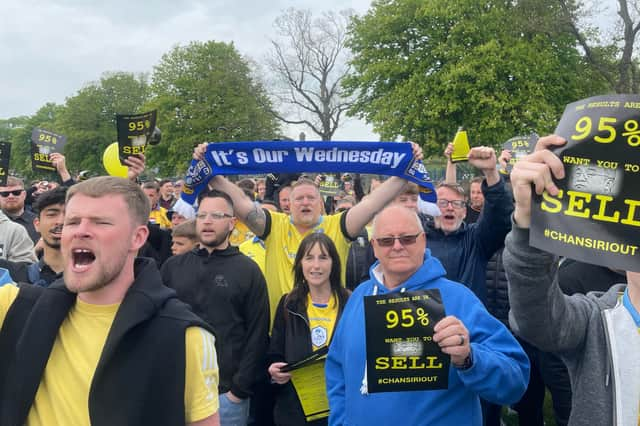
Saturday marked the most powerful protest yet by Sheffield Wednesday fans calling for Dejphon Chansiri to step away from the club. Alex Miller looks back on an afternoon dominated by yellow and black.
On picnic tables near the Crucible Theatre, where John Higgins was sealing an exciting win over Xiao Guodong in the World Snooker Championships, a middle-aged couple sipped tea and watched the action on the big screen. Just behind them, banners were being raised and chatter grew louder as a small group gathered. A few dozen supporters, many in yellow, watched from the nearby Head of Steam pub as Supporters Trust chairman Ian Bennett delivered a passionate speech before leading a march towards Hillsborough.
After covering the initial stages, The Star decided a four-mile walk was too much and headed back toward the snooker crowd. A man in a Nottingham Forest jacket, curious about the filming, asked what was happening. On hearing about the protest, he nodded knowingly, relating it to his club’s past struggles.
That early gathering at The Crucible was significant more for its symbolism than its size. Taking the protest into the city centre during Sheffield’s biggest cultural event was meaningful, but the turnout felt underwhelming—highlighting the gap between online outrage and real-world action. It raised doubts about whether the message could reach as far as Chansiri in Bangkok when it barely caused a stir just metres from the snooker.
But then.
By 2pm at Hillsborough Park, the mood had completely shifted. A crowd easily numbering into the thousands gathered, united in a passionate, reasonable, and determined protest. Apart from a few off-color chants, the atmosphere was one of solidarity across all ages and backgrounds. The sight of the mass of fans moving towards Hillsborough was striking, underlining a growing unity among different fan groups who had been angered by recent mismanagement. Conversations with attendees suggested a shift from a previously wide range of opinions to a more singular, critical voice.
A recurring sentiment, even from those not joining the march, was that patience was running thin: many said they’d already bought season tickets but would not renew if Chansiri stayed beyond next season.
The protest was organised by the Sheffield Wednesday Supporters Trust, although a recent communication misstep had caused some friction among fan groups. While that incident didn’t seem to dampen the day’s success, it highlighted the need for better coordination moving forward—something the Trust board acknowledges.
Chansiri himself was not at the match, contrary to rumors, though at least one of his brothers reportedly watched from the directors’ box until near the end. Meanwhile, extra security was posted to protect the golden elephant statues at Hillsborough, now a symbol of Chansiri’s era. Before kick-off, an elderly fan, supported by a young relative, raised a banner and shouted his frustrations through the stadium’s reception doors.
The protest carried on inside the stadium, with yellow and black balloons filling the air during a mostly forgettable 1-1 draw with Portsmouth. Deflated balloons scattered across the pitch served as a constant reminder of the real story unfolding.
Following earlier, less successful protest efforts—including the controversial 1867 Group—the momentum has finally grown significantly. Yet uncertainty lingers: questions about Chansiri’s willingness to sell, the club’s future direction, and the looming threat of the EFL’s 30-day rule all remain unanswered.
One thing, however, is certain: the anger and determination among the fanbase have reached unprecedented levels. With a long summer ahead, it remains to be seen whether this new spirit of resistance will continue to build. But for now, Sheffield Wednesday’s supporters have found their voice.







